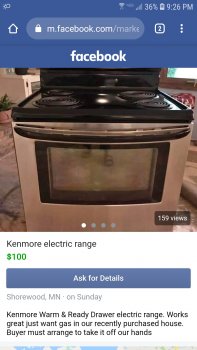I had to laugh when I looked at that Instructables article about toaster ovens. I know some of you folks use believe different, but I know that just putting a PID in a toaster oven doesn't make it accurate. If you leave it like the pic in the article......you're just wasting your money on a PID, and your time installing it.
Ed has forgotten more than I will ever know about knifemaking, and I really appreciate Ed sharing his knowledge with us on this forum. I have learned LOTS from watching his videos, reading his posts, and talking with Ed in person at Blade. BUT - we have dis-agreed in the past on epoxy life. I'm not sure if the 3 experts I brought into the discussion were enough to convince Ed on epoxy life or not. I expect this discussion on toaster ovens will have the same result. Ed's mind is made up, he tried it before, didn't work and that's that.
I've been following this thread and I'm curious about convection ovens. Has anyone tried a small convection toaster oven? Since air is constantly circulating I would think they would keep a fairly even temperature, but I really don't know.
After reading this thread I'm ready to ditch my current toaster oven for something better.
Sean, you asked about the convection ovens with air circulating, it's not the lack of circulation that's the problem, it's the type of t'stat used in most of the older kitchen or toaster ovens. The newer type digital controlled kitchen (or toaster) ovens provide better control, not quite up to PID accuracy, but still pretty darn good.
Allow me to explain a VERY simplified version of temperature control: The older style T'stat has a bi-metal coil that moves as it heats or cools opening or closing a contact. This isn't all that accurate and happens at set point. A PID (Proportional–Integral–Derivative
controller) controllers "learns" where the contact needs to open or close to to keep temp at setpoint. Ideally the PID would slowly reduce amount of heat as temperature approaches setpoint so there is little overshoot. It seems most of the cheap PIDs used simply open or close a relay rather than reducing heat, it shuts heat OFF or ON. That is why it takes a while to settle down to temperature (as well as heating up the mass in oven). Say setpoint is 300°F, first cycle the PID might open contact at 300, see the temp overshoot to 325. Contact stays open until temp falls to 300, PID thinks might better let it fall a bit more, then at 290 contact closes and temp rises to 298 and contact opens but temp still rises to 310 this time. This cycle continues as the PID learns where to open and close contact to keep temperature right at 300°F setpoint. This is called the "Learning" portion of setup. Once this has cycled thru and the PID has learned the correct parameters, the PID will still overshoot and undershoot during heat up, but it will be less each time.
There is no reason in the world a small enclosure can't be temperature controlled as well as a large enclosure. It's all about the type of controls and heating element, not the cubic volume of enclosure. Check with any process control engineer on that. For anyone who needs to do lots of blades at a time a kitchen stove/oven makes sense. Mydigital kitchen oven will provide ±5°F just fine and that should be all that's needed. A PID controlled toaster oven with an extra fire brick for mass has no problem providing ±1°F control, and certainly ±2°F control is expected.
For the folks here (like me) who seldom do more than a couple of chef blades, or a 4 set of steak knives at a time a toaster oven with PID control makes good sense.
I had no intention of this getting so long, just started typing.
Ken H>





